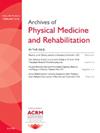Engaging Rural Caregivers to Evaluate, Tailor, and Implement the Whole Health Caregiver THRIVE Program for Continuous Adaptation and Improvement
IF 3.6
2区 医学
Q1 REHABILITATION
Archives of physical medicine and rehabilitation
Pub Date : 2025-04-01
DOI:10.1016/j.apmr.2025.01.077
引用次数: 0
Abstract
Objectives
Approximately 5.5 million informal caregivers in the United States (eg, family members) assist with activities of daily living and medical tasks. Caregivers are essential in providing support to veterans but often experience emotional and physical strain, which can result in burnout and impact caregiving capacity. This work aimed to engage rural caregivers to evaluate, tailor, and implement Transforming Health and Resiliency through Integration of Values-based Experiences (THRIVE) program for caregivers.
Design
A mixed-methods human-centered design approach was used to develop and evaluate intervention content.
Setting
A Whole Health service flagship at a Veterans Affairs (VA) hospital within the southeast United States. Due to remote recruitment, participants were geographically dispersed.
Participants
Participants were informal caregivers (ie, cohort 1, n=13; cohort 2, n=22) to VA veteran patients.
Interventions
THRIVE is a 7-week, remotely delivered evidence-based VA program designed to provide access to complementary and integrative health (CIH) based self-care. This program was originally developed for veterans and VA employees. The adapted Caregiver THRIVE program addresses caregivers’ wellness and QoL including burnout; CIH and wellness; mindfulness; and values-based living.
Main Outcome Measures
The main outcome measures include burnout, guilt, mindfulness, mental, and physical-related QoL.
Results
Majority of participants are rurally located (38.31%), white (74.67%), an average age of 61 years old, married, female caregivers (86.36%), with an associate's degree or higher (64.29%). Caregiver THRIVE was generally well-received and perceived helpful. Outcomes included improvements (as measured by standardized mean differences [SMD]) in burnout (SMD, −0.13), guilt (SMD, 0.23), mindfulness (SMD, 0.46), mental health-related quality of life (HRQoL) (SMD, 0.25), and physical HRQoL (SMD, 0.24). Preprogram to postprogram change scores indicated possible improvements for (QoL) (SMD, 0.24; ES, small).
Conclusions
Caregiver THRIVE has the potential to assist caregivers in acquiring knowledge and skills to maintain a healthy lifestyle, create community, and reduce burnout, particularly for rurally located caregivers. Periodic evaluation with caregivers appears crucial for continuous adaptation and program improvement.
Disclosures
This work is supported by the Department of Veterans Affairs, Veterans Health Administration, Office of Rural Health, Veterans Rural Health Resource Center Veterans Health Administration, Office of Rural Health, Veterans Rural Health Resource Center – Iowa City, Iowa City (NOMAD PROJ-03860) with IRBNet #1714908-2. This is the result of work supported with resources and the use of facilities and personnel at the James A. Haley Veterans’ Hospital. Contents do not represent the views of the Department of Veterans Affairs of the United States Government.
求助全文
约1分钟内获得全文
求助全文
来源期刊
CiteScore
6.20
自引率
4.70%
发文量
495
审稿时长
38 days
期刊介绍:
The Archives of Physical Medicine and Rehabilitation publishes original, peer-reviewed research and clinical reports on important trends and developments in physical medicine and rehabilitation and related fields. This international journal brings researchers and clinicians authoritative information on the therapeutic utilization of physical, behavioral and pharmaceutical agents in providing comprehensive care for individuals with chronic illness and disabilities.
Archives began publication in 1920, publishes monthly, and is the official journal of the American Congress of Rehabilitation Medicine. Its papers are cited more often than any other rehabilitation journal.

 求助内容:
求助内容: 应助结果提醒方式:
应助结果提醒方式:


